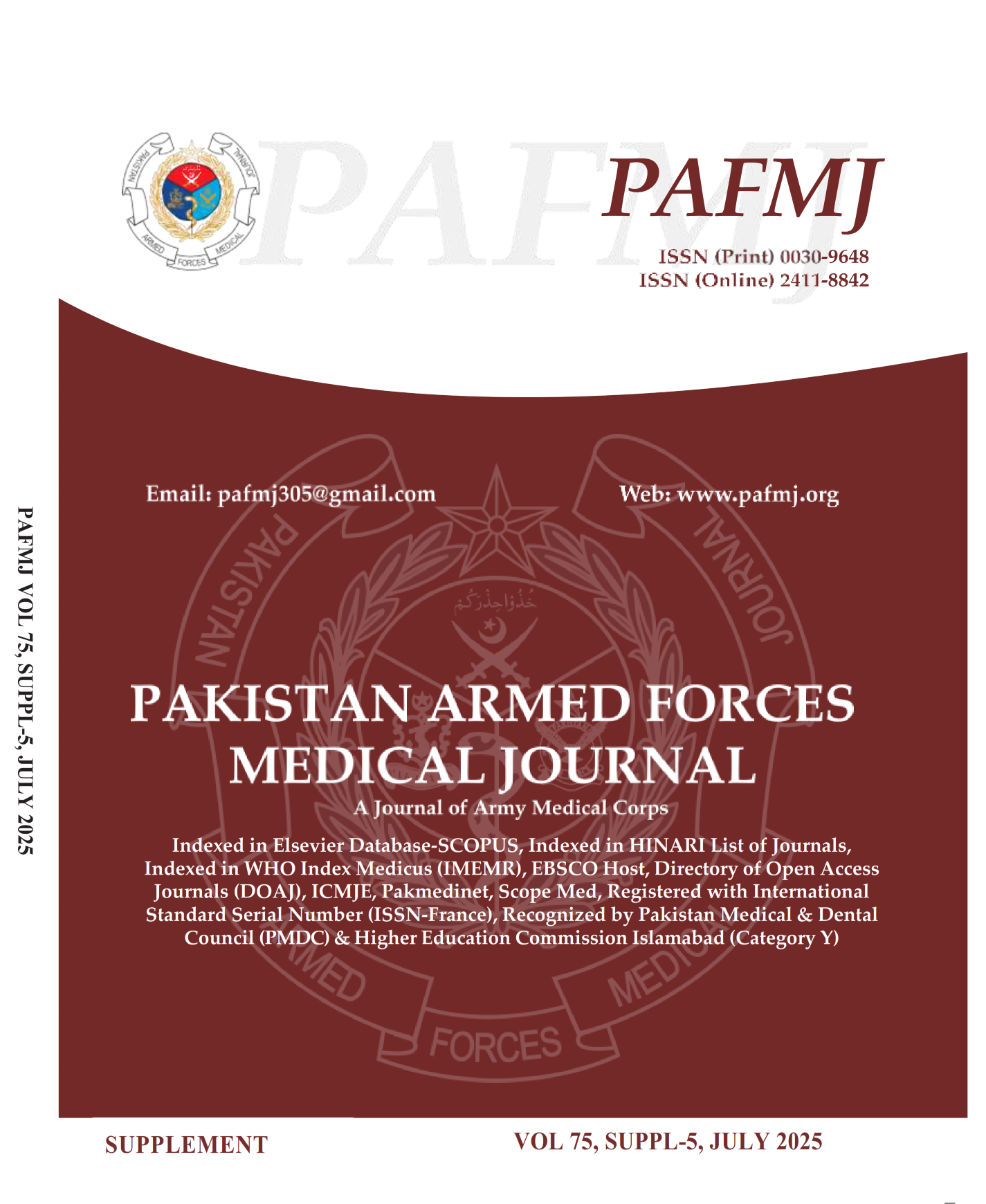Progression of Infected Diabetic Foot Ulcers to Amputation Cases; A Comparative Study of Meropenem vs Linezolid Treatments
DOI:
https://doi.org/10.51253/pafmj.v75iSUPPL-5.6710Keywords:
Amputations, Diabetic Foot Disease, Linezolid, Meropenem.Abstract
Objective: To study the effectiveness of Linezolid in comparison to Meropenem for diabetic foot disease in terms of decreasing the number of amputations and infection clearance.
Study Design: Quasi Experimental Study.
Place and Duration of Study: Department of General Surgery, Combined Military Hospital, Rawalpindi Pakistan, from Jan 2020 to Apr 2021.
Methodology: A total of 188 patients suffering from diabetic foot disease who met the inclusion criteria were included. Patients were divided into two Groups, Group A received Linezolid while Group B received Meropenem at standard doses. Patients were evaluated after 10 days of antibiotic therapy. All patients received testing for pre- and post-treatment C-reactive protein levels and progression to amputation within 6 months which were checked across both Groups for improvement as an indicator of treatment effectiveness. Data was analyzed by SPSS 26.0.
Results: The mean C-reactive protein level on enrollment for Group A was 84.71±27.29 mg/L, while the same was 83.33±26.74 mg/L in Group B (p=0.73). These levels were 6.84±5.5 mg/L and 8.94±8.73 in Groups A and B, respectively, post-treatment (p=0.049). Treatment was declared successful in 84(89.4 %) with Linezolid, while in 72(76.6%) on Meropenem (p=0.02). A total of 6(6.4%) patients underwent amputation at 6 months in the Linezolid Group versus 2(2.1%) in the Meropenem Group, p=0.14.
Conclusion: Linezolid is an effective drug for which can be used in the management of diabetic foot disease with different clinical manifestations. It demonstrates superiority to Meropenem in terms of clearance of infection and progression to amputation.
Downloads
References
1. Meo SA, Zia I, Bukhari IA, Arain SA. Type 2 diabetes mellitus in Pakistan: Current prevalence and future forecast. J Pak Med Assoc 2016; 66(12): 1637-1642.
2. Armstrong DG, Boulton AJM, Bus SA. Diabetic Foot Ulcers and Their Recurrence. N Engl J Med 2017; 376(24): 2367-2375.
3. Mutluoglu M, Uzun G, Turhan V, Gorenek L, Ay H, Lipsky BA. How reliable are cultures of specimens from superficial swabs compared with those of deep tissue in patients with diabetic foot ulcers? J Diabetes Complications 2012; 26(3): 225-229.
4. Kim PJ, Steinberg JS. Complications of the diabetic foot. Endocrinol Metab Clin North Am 2013; 42(4): 833-847.
5. Singer AJ, Tassiopoulos, Kirsner RS. Evaluation and Management of Lower-Extremity Ulcers. N Engl J Med 2018; 378(3): 302-303.
6. Everett E, Mathioudakis N. Update on management of diabetic foot ulcers. Ann N Y Acad Sci 2018; 1411(1): 153-165.
7. Wu WX, Liu D, Wang YW, Wang C, Yang C, Liu XZ, et al. Empirical Antibiotic Treatment in Diabetic Foot Infection: A Study Focusing on the Culture and Antibiotic Sensitivity in a Population From Southern China. Int J Low Extrem Wounds 2017; 16(3): 173-182.
8. Fish DN. Meropenem in the treatment of complicated skin and soft tissue infections. Ther Clin Risk Manag 2006; 2(4): 401-415.
9. Eslam RB, Burian A, Vila G, Sauermann R, Hammer A, Frenzel D, et al. Target site pharmacokinetics of linezolid after single and multiple doses in diabetic patients with soft tissue infection. J Clin Pharmacol 2014; 54(9): 1058-1062.
10. Traunmüller F, Schintler MV, Spendel S, Popovic M, Mauric O, Scharnagl E, et al. Linezolid concentrations in infected soft tissue and bone following repetitive doses in diabetic patients with bacterial foot infections. Int J Antimicrob Agents 2010; 36(1): 84-86.
11. Lipsky BA, Itani K, Norden C; Linezolid Diabetic Foot Infections Study Group. Treating foot infections in diabetic patients: a randomized, multicenter, open-label trial of linezolid versus ampicillin-sulbactam/amoxicillin-clavulanate. Clin Infect Dis 2004; 38(1): 17-24.
12. Navarro-Peternella FM, Lopes APAT, de Arruda GO, Teston EF, Marcon SS. Differences between genders in relation to factors associated with risk of diabetic foot in elderly persons: A cross-sectional trial. J Clin Transl Endocrinol 2016; 6(10): 30-36.
https://doi.org/doi: 10.1016/j.jcte.2016.10.001
13. Wilcox M, Nathwani D, Dryden M. Linezolid compared with teicoplanin for the treatment of suspected or proven Gram-positive infections. J Antimicrob Chemother 2004; 53(2): 335-344.
14. Yazdanpanah L, Shahbazian H, Nazari I, Arti HR, Ahmadi F, Mohammadianinejad SE, et al. Incidence and Risk Factors of Diabetic Foot Ulcer: A Population-Based Diabetic Foot Cohort (ADFC Study)-Two-Year Follow-Up Study. Int J Endocrinol 2018; 7631659.
15. Fincke BG, Miller DR, Turpin R. A classification of diabetic foot infections using ICD-9-CM codes: application to a large computerized medical database. BMC Health Serv Res 2010; 10(7): 192.
16. Younis BB, Shahid A, Arshad R, Khurshid S, Ahmad M, Yousaf H. Frequency of foot ulcers in people with type 2 diabetes, presenting to specialist diabetes clinic at a Tertiary Care Hospital, Lahore, Pakistan. BMC Endocr Disord 2018; 18(1): 53.
17. Sekhar S, Vyas N, Unnikrishnan M, Rodrigues G, Mukhopadhyay C. Antimicrobial susceptibility pattern in diabetic foot ulcer: a pilot study. Ann Med Health Sci Res 2014; 4(5): 742-745.
18. Nageen A. The Most Prevalent Organism in Diabetic Foot Ulcers and Its Drug Sensitivity and Resistance to Different Standard Antibiotics. J Coll Physicians Surg Pak 2016; 26(4): 293-296.
Downloads
Published
Issue
Section
License
Copyright (c) 2025 Muhammad Zain Farooq, Khalid Mahmood, Muhammad Arsalan Zafar, Sohail Saqib Chatha, Muhammad Farhan Saeed, Tansheet Mazhar Qureshi

This work is licensed under a Creative Commons Attribution-NonCommercial 4.0 International License.















